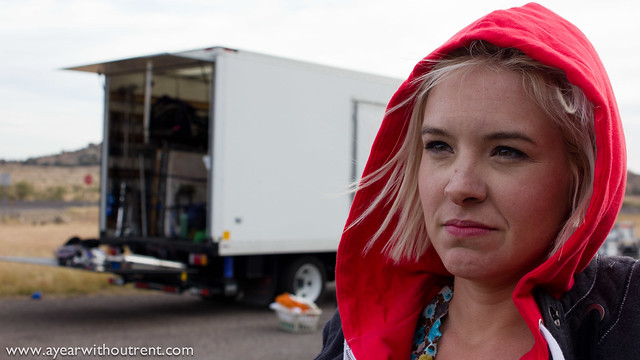
We need a different desolate section of highway for Day 3 of BEST FRIENDS FOREVER, one we haven't seen in the first two days, and so we load up the grip truck (minus the picture car) and drive southwest out of town until all you can see is the emptiness of the road for miles and miles in every direction.
It's about a mile and a half away. You could walk there rather easily.
Such is life in Marfa, Texas.

We're shooting a scene where Brea Grant and Vera Miao walk down the middle of a highway, and while we've got permits to shoot on this stretch of road, we don't exactly have the road blocked off from traffic, mostly because there isn't any. Oh sure, a car comes through every half hour or so, but you can see it well in advance, and it doesn't even qualify as being urgent enough to cut a take short. It's a simple walk-and-talk, think Aaron Sorkin in the middle of nowhere, which means that all we've really got to do is bounce some light around.


Enter the 12x frame with some unbleached muslin.
There's no point in putting it on a stand, as we've got to move it as they walk, and we don't want to put more in the road than we have to, so all we really have to do is walk with it and make sure the wind doesn't pick up and turn it into a sail.
It's a two person job. We have four people, which leaves plenty of time to do housekeeping tasks like figuring out how to best organize the grip truck and taking photos of various crew members looking like desperadoes. Because if you were there, you would want a photo of you looking like a desperado.


In-between takes, I jump in and take some publicity stills, as this is a picturesque spot and kind of mimics the poster concept they're working off of.
Then, by lunch we're done and it's back over to the rest area we filmed at yesterday for the second half of today's shoot. Phil and I swing by the house to pick up the picture car, and then we're off.

We have to finish up the scenes with the hipsters, which requires further use of our stunt coordinator, Robbie Corbett.


I'm not sure how much I'm supposed to talk about the specifics of the stunt, but let's just say it involves the car and Robbie wearing clothes that don't fit. But here's the thing, a stunt involving a car is difficult (and dangerous, obviously). You've got to time everything just right or it'll look like shit. And that's hard enough if the car is a normal, functioning car that does things like start and run without stalling. But this car, the WAYNE'S WORLD AMC Pacer, is no normal car. It starts when it feels like it, and stalls more often than not. You would never, ever want this as a stunt car, unless the stunt involved pushing it off a cliff or blowing it up with a rocket launcher.

But that's the stunt car we have. And we need the shot, so we do our best.
It goes about as well as you could hope, all things considered. It doesn't help that the wind is whipping around at ungodly speeds, making it necessary to do things like stand on a c-stand because the sandbags just aren't strong enough. But even with all that wind, the winged insects are out, and they're friendly. Really, really friendly. Weirdly friendly.

Filmmaker Lucas McNelly is spending a year on the road, volunteering on indie film projects around the country, documenting the process and the exploring the idea of a mobile creative professional. You can see more from A Year Without Rent at the webpage. His feature-length debut is now available to rent on VOD. Follow him on Twitter: @lmcnelly.












